March 6, 2023
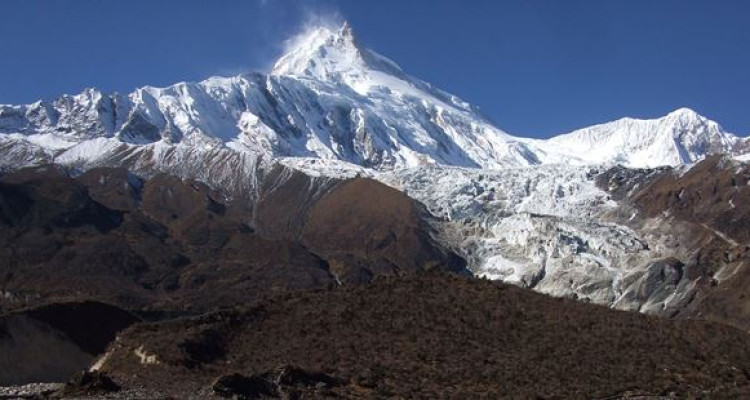
⇒ An Overview of the Manaslu Trek
⇒ Preparing for high altitude trekking around Manaslu region
⇒ Trekking equipment checklist for Manaslu trek
⇒ Physical fitness and training tips for manaslu trek
⇒ The Best Time to Trek the Manaslu trek
⇒ Budget and cost of trekking the Manaslu Circuit
⇒ Permits and regulations for the Manaslu Circuit Trek
⇒ Safety tips for manaslu trekking in Nepal
⇒ Trekking itinerary for the Manaslu Circuit
⇒ Accommodation options on the Manaslu trek
⇒ Food and drink options on the Manaslu trek
⇒ Cultural experiences on the Manaslu Circuit Trek
⇒ Wildlife and flora on the Manaslu Circuit Trek
⇒ Side trips and attractions in the Manaslu region trek
⇒ The Spiritual Significance of the Manaslu Region
⇒ The Impact of Climate Change on the Manaslu Trek
⇒ Manaslu Trek Weather and Temperature
⇒ A Comparison of the Different Routes on the Manaslu Trek
⇒ Tips for Staying Safe on the Manaslu Trek
⇒ Conclusion
The Manaslu Trek is a popular trekking route in Nepal that offers stunning views of the Himalayan mountain range and the local culture of the region. The trek circles the eighth-highest mountain in the world, Mt. Manaslu (8,163m), and passes through various landscapes and diverse ethnic communities.
The trek begins from Arughat, a small town in the Gorkha district of Nepal, and follows the Budhi Gandaki River through lush green forests, rice paddies, and traditional Nepalese villages. The trail then ascends to higher altitudes, passing through alpine forests and crossing several high mountains passes before reaching the Manaslu Base Camp.
The trek offers some of the most breathtaking views of the Himalayan mountain range, including Mt. Manaslu, Mt. Himalchuli, Mt. Ganesh Himal, and Mt. Annapurna. Along the way, trekkers can experience the local culture of the region by visiting traditional villages and interacting with the locals.
The trek is challenging, and trekkers need to be in good physical condition to complete it. The highest point of the trek is the Larkya La Pass (5,160m), which requires proper acclimatization and preparation. The best time to do the Manaslu Trek is during the autumn and spring seasons when the weather is stable and clear.
The Manaslu Trek is a restricted trekking route, and trekkers need to obtain a special permit from the Nepalese government to enter the region. The permit can only be obtained through a registered trekking agency, and trekkers need to be accompanied by a licensed guide.
Overall, the Manaslu Trek is a challenging and rewarding trekking experience that offers stunning mountain views and a glimpse into the unique culture of the region.
Preparing for high-altitude trekking around the Manaslu region is essential to ensure a safe and enjoyable experience. Here are some important things to consider when preparing for high-altitude trekking:
Physical Fitness: Trekking at high altitudes requires a good level of physical fitness. It is recommended to start exercising and training a few months before the trek. This can include cardio exercises such as running, hiking, or cycling, as well as strength training and stretching.
Altitude Sickness: Altitude sickness is a common problem for trekkers at high altitudes. It is caused by lower oxygen levels and reduced air pressure at higher altitudes. Symptoms of altitude sickness include headache, nausea, dizziness, and shortness of breath. To prevent altitude sickness, it is recommended to acclimatize properly, drink plenty of fluids, and avoid alcohol and smoking.
Packing List: A proper packing list is essential for high-altitude trekking. It should include warm and waterproof clothing, sturdy trekking boots, a sleeping bag, a backpack, a first aid kit, and other essential items such as a headlamp, sunscreen, and sunglasses.
Permits and Regulations: The Manaslu Circuit Trek requires a special trekking permit, which can be obtained through a registered trekking agency in Nepal. It is also important to follow the regulations of the Manaslu Conservation Area, such as staying on the designated trekking trail and respecting the local culture and traditions.
Hiring a Guide and Porter: Hiring a professional guide and porter can greatly enhance the trekking experience and ensure safety and comfort. A guide can provide valuable information about the local culture and history, as well as help with navigation and communication. A porter can carry a heavy backpack and make the trekking experience more enjoyable.
By following these tips and preparing properly, trekkers can have a safe and enjoyable high-altitude trekking experience around the Manaslu region.

Trekking in Manaslu can be a challenging and rewarding experience. It is important to be prepared with the right equipment to ensure your safety and comfort throughout the trek. Here is a checklist of essential equipment for a Manaslu trek:
Clothing
Footwear
Sleeping gear
Other essentials
It is also recommended to hire a porter to carry your gear, as the trek can be physically demanding. Make sure to do your research and choose a reputable trekking company to ensure a safe and enjoyable experience.
Physical fitness and training tips
The Manaslu Trek in Nepal is a physically demanding trek that requires good fitness levels and endurance. It is important to prepare yourself physically before embarking on the trek to ensure a safe and enjoyable experience. Here are some physical fitness and training tips for the Manaslu Trek:
Cardiovascular Exercise: Cardiovascular exercises such as running, cycling, or swimming helps to improve your overall fitness and stamina. Aim to do at least 30 minutes of cardio exercise three to four times a week.
Strength Training: Strength training exercises such as squats, lunges, and calf raises can help to build up the muscles in your legs and improve your endurance. Aim to do strength training exercises two to three times a week.
Hiking: Practice hiking with a loaded backpack or trekking poles to simulate the conditions you will encounter on the trek. Gradually increase the distance and elevation of your hikes over time.
Altitude Training: The Manaslu Trek reaches high altitudes, so it is important to prepare yourself for the thin air. Consider training at high altitudes or using altitude training equipment to acclimatize your body.
Stretching: Stretching can help to improve your flexibility and reduce the risk of injury. Incorporate stretching into your daily routine, especially after exercise.
Nutrition: Eating a healthy and balanced diet is important for maintaining your energy levels and supporting your training. Focus on foods that are high in protein, complex carbohydrates, and healthy fats.
Remember to listen to your body and adjust your training plan accordingly. If you experience any pain or discomfort, consult with a medical professional before continuing your training. It is also important to pace yourself during the trek and allow time for rest and acclimatization.
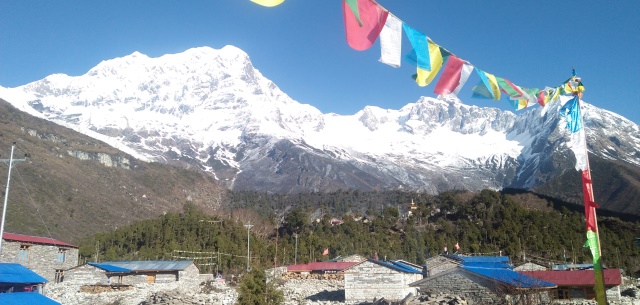
The Manaslu Circuit is a popular trekking route in Nepal, which offers stunning views of the Himalayan range, unique culture, and diverse landscapes. The best time to trek the Manaslu Circuit is from mid-September to mid-November and from March to May.
During these months, the weather is relatively stable, with clear skies, and the temperature is mild, making it ideal for trekking. The views of the mountains are also spectacular during these months, and the trails are generally dry and safe to hike.
In contrast, the monsoon season from June to August brings heavy rain, making the trail slippery and difficult to trek. In winter, from December to February, the region receives heavy snowfall, which makes the trails impassable, and the temperature drops significantly, making it challenging to trek.
Therefore, the best time to trek the Manaslu Circuit is during the spring (March to May) and autumn (mid-September to mid-November) seasons when the weather is dry, and the temperature is mild. However, it’s always essential to check the weather forecast before embarking on any trekking adventure.
The cost of trekking the Manaslu Circuit can vary depending on several factors such as the length of the trek, the season, the mode of transportation, and the type of accommodation chosen. Here’s a breakdown of the estimated budget for trekking the Manaslu Circuit:
Permits: The Manaslu Conservation Area Permit (MCAP) costs USD 30 per person for the first seven days, and every additional day costs USD 10 per person. The Annapurna Conservation Area Permit (ACAP) costs USD 30 per person.
Guide and porter: It is compulsory to hire a licensed guide for trekking the Manaslu Circuit. The cost of hiring a guide can range from USD 20 to USD 30 per day. If you need a porter, the cost is typically around USD 15 to USD 20 per day, including their accommodation, food, and insurance.
Accommodation: The cost of accommodation can vary depending on the type of accommodation chosen. The tea houses along the Manaslu Circuit offer basic accommodation with shared bathrooms and meals. The cost of accommodation can range from USD 5 to USD 15 per night.
Food: The cost of food can also vary depending on the menu and location. The average cost of a meal in a tea house is around USD 5 to USD 10.
Transportation: The cost of transportation can vary depending on the mode of transportation chosen. The most common mode of transportation is a bus, which costs around USD 10 to USD 20 per person. If you take a private transport such as a jeep or van it would cost 150 USD.
Based on these estimates, the total cost of trekking the Manaslu Circuit for 10 to 12 days can range from USD 800 to USD 1500 per person, excluding airfare and personal expenses. However, the cost can be significantly reduced if you trek independently, without a guide or porter.
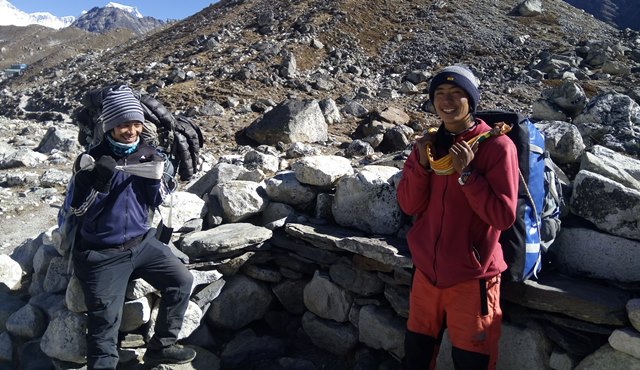
Porter resting
The Manaslu Circuit Trek is a popular trekking route in Nepal, and as such, there are certain permits and regulations that trekkers need to be aware of before embarking on the trek. Here are the permits and regulations required for the Manaslu Circuit Trek:
Restricted Area Permit: The Manaslu Circuit Trek is considered a restricted area, and all trekkers are required to obtain a Restricted Area Permit (RAP) before starting the trek. The RAP costs $70 USD for the first week and $10 USD for each additional day. The permit can only be obtained through a registered trekking agency in Nepal.
Manaslu Conservation Area Permit: The Manaslu Conservation Area is a protected area in Nepal, and all trekkers are required to obtain a Manaslu Conservation Area Permit (MCAP) before starting the trek. The MCAP costs $30 USD per person and can be obtained through the Nepal Tourism Board or a registered trekking agency in Nepal.
TIMS Card: All trekkers are required to obtain a Trekker’s Information Management System (TIMS) card before starting the trek. The TIMS card costs $10 USD per person and can be obtained through the Nepal Tourism Board or a registered trekking agency in Nepal.
Guide and Porter: All trekkers are required to hire a registered guide and porter for the Manaslu Circuit Trek. The guide and porter will assist with navigation, carry equipment, and ensure the safety of the trekker. This requirement is in place to promote safety and reduce the risk of accidents.
Minimum Group Size: The Manaslu Circuit Trek requires a minimum group size of two trekkers. This is a safety measure to ensure that trekkers have someone to assist them in case of an emergency.
It is important to note that these regulations are subject to change, so it is always best to check with the Nepal Tourism Board or a registered trekking agency in Nepal for the most up-to-date information.
Trekking in the Manaslu region of Nepal is an amazing experience, but it’s important to take safety precautions to ensure a safe and enjoyable journey. Here are some safety tips to keep in mind when trekking in the Manaslu region:
Acclimatize properly: Altitude sickness is a serious risk when trekking in the Manaslu region. It’s important to take enough time to acclimatize and avoid ascending too quickly. Drinking plenty of water, resting, and listening to your body are all important steps to take.
Dress appropriately: The weather in the Manaslu region can be unpredictable, so it’s important to dress in layers and bring warm clothing. Rain gear is also essential.
Hire a licensed guide and porter: Hiring a licensed guide and porter can help you stay on the right path, carry your gear, and provide safety assistance if needed. Additionally, having a guide who is familiar with the area can help you avoid hazards and stay safe.
Stay hydrated: Drink plenty of water to stay hydrated, especially at higher altitudes. Dehydration can exacerbate altitude sickness symptoms.
Avoid solo trekking: It’s best to trek with a group or at least one other person. Solo trekking increases the risk of getting lost or injured without assistance.
Be cautious on the trail: Pay attention to your surroundings and watch for hazards such as loose rocks or steep drops. Trekking poles can provide extra stability on difficult terrain.
Respect local customs and culture: When trekking in the Manaslu region, it’s important to respect the local customs and culture. Dress modestly and ask permission before taking photos of people or religious sites.
Carry a first aid kit: Be prepared for minor injuries and illnesses by carrying a basic first aid kit with essential items such as bandages, pain relievers, and antiseptic.
Overall, it’s important to prepare well and take necessary precautions to ensure a safe and enjoyable trek in the Manaslu region of Nepal.
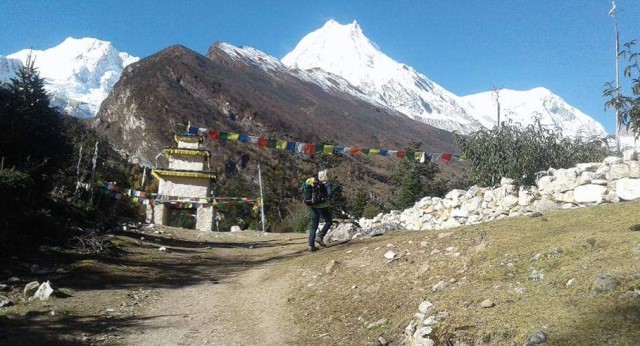
The Manaslu Circuit is a popular trekking route in Nepal that takes you through a stunning landscape, remote villages, and high mountain passes. Here’s a suggested 12-day itinerary for the Manaslu trek:
Day 1: Drive from Kathmandu to Soti Khola (710m/2,330ft) – 8-9 hours
Day 2: Trek from Soti Khola to Machha Khola (900m/2,952ft) – 6-7 hours
Day 3: Trek from Machha Khola to Jagat (1,410m/4,626ft) – 6-7 hours
Day 4: Trek from Jagat to Deng (1,804m/5,917ft) – 6-7 hours
Day 5: Trek from Deng to Namrung (2,630m/8,626ft) – 6-7 hours
Day 6: Trek from Namrung to Samagaon (3,530m/11,578ft) – 6-7 hours
Day 7: Rest day in Samagaon for acclimatization and exploration
Day 8: Trek from Samagaon to Samdo (3,860m/12,660ft) – 3-4 hours
Day 9: Trek from Samdo to Dharmasala/Larkya Phedi (4,460m/14,632ft) – 4-5 hours
Day 10: Trek from Dharmasala to Bhimthang (3,720m/12,201ft) via Larkya La Pass (5,160m/16,930ft) – 8-9 hours
Day 11: Trek from Bhimthang to Dharapani (1,960m/6,430ft) – 7-8 hours
Day 12: Drive from Dharapani to Besisahar (820m/2,690ft) and then to Kathmandu – 9-10 hours
Note: The trekking hours mentioned in the itinerary are approximate and can vary depending on your pace and the conditions of the trail. It’s essential to be adequately prepared for the high altitude and have the necessary equipment, permits, and a reliable guide to accompany you on the trek.
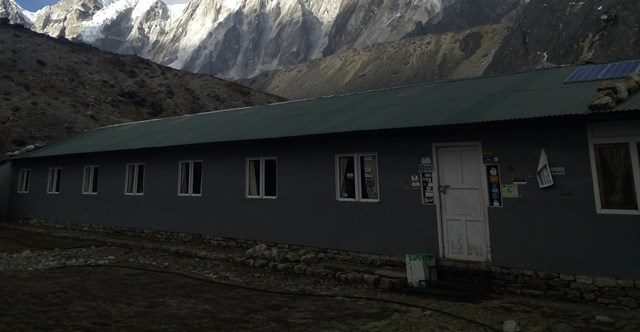
The Manaslu Circuit trek offers a variety of accommodation options ranging from basic teahouses to comfortable lodges. Here are some of the accommodation options available on the trek:
Teahouses: These are basic guesthouses that offer a bed and a shared bathroom. The rooms are often small and sparsely furnished, but they are clean and provide a comfortable place to rest. The teahouses are usually run by local families and offer a chance to experience the local culture and hospitality.
Lodges: Lodges are more comfortable than teahouses and offer private rooms with attached bathrooms. They often have a restaurant that serves Nepali and international cuisine. Lodges are a great option for those who prefer a bit more comfort and privacy on their trek.
Camping: If you prefer a more secluded experience, camping is a good option. You can hire a guide and a porter to carry the equipment and set up camp for you. You can enjoy the stunning views of the Manaslu range and the starry night sky from your own private campsite.
It’s essential to book your accommodation in advance, especially during the peak trekking seasons (March to May and September to November), as the accommodation can fill up quickly. It’s also important to note that the higher you go on the trek, the more basic the accommodation options become.
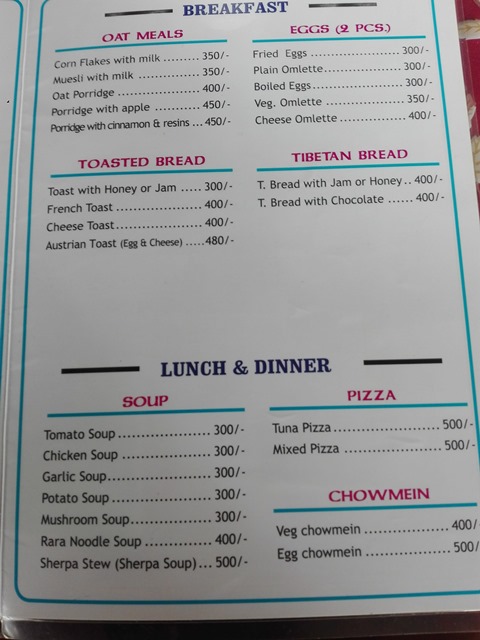
Menu for food while trekking in the Manaslu region
The Manaslu Circuit trek offers a variety of food and drink options to keep you energized and hydrated during the trek. Here are some of the food and drink options available on the trek:
Nepali Dal Bhat: Dal Bhat is a staple dish in Nepal and consists of boiled rice, lentil soup, and vegetable curry. It’s a nutritious and filling meal that will provide you with the energy you need for the trek.
Momos: Momos are a popular snack in Nepal and consist of steamed or fried dumplings filled with meat or vegetables. They are a great option for a quick snack or lunch on the trek.
Thukpa: Thukpa is a traditional Nepali soup that consists of noodles, vegetables, and meat in a flavorful broth. It’s a warming and satisfying meal that is perfect for cold days on the trek.
Tea and Coffee: Tea and coffee are readily available on the trek and are a great way to warm up and recharge. Nepali tea is particularly delicious and is made with milk, sugar, and spices like cardamom and cinnamon.
Snacks: You can find a variety of snacks like biscuits, chocolate bars, and energy bars at the teahouses and lodges. These are a great option for a quick energy boost during the trek.
It’s important to stay hydrated during the trek, so make sure to drink plenty of water. You can also find a variety of soft drinks and fruit juices at the teahouses and lodges. It’s recommended to avoid alcohol during the trek as it can dehydrate you and affect your acclimatization.
The Manaslu Circuit trek offers a variety of cultural experiences, including opportunities to interact with the local communities and learn about their traditions and customs. Here are some of the cultural experiences you can have on the trek:
Visit Monasteries: The Manaslu region is home to several ancient monasteries that are important pilgrimage sites for Buddhists. You can visit these monasteries and learn about their history and significance.
Stay in Local Villages: The trek passes through several remote villages where you can stay in teahouses run by local families. You can interact with the locals, learn about their way of life, and even try your hand at traditional activities like farming and weaving.
Experience Local Festivals: The Manaslu region is home to several colorful festivals that are celebrated throughout the year. If you’re lucky, you may be able to witness these festivals and participate in the festivities.
Try Local Food: The local cuisine of the Manaslu region is delicious and unique. You can try traditional dishes like Dal Bhat, Momos, and Thukpa and learn about the local ingredients and cooking techniques.
Learn About Local Crafts: The Manaslu region is known for its traditional crafts like weaving, pottery, and metalwork. You can visit local artisans and learn about their craft and even purchase some souvenirs to take back home.
It’s important to be respectful of the local customs and traditions and to ask for permission before taking photographs or participating in any activities. Interacting with the locals and learning about their way of life can be a rewarding and enriching experience on the trek.
The Manaslu Circuit Trek is a popular trekking route in Nepal that offers stunning views of the Himalayan mountain range and its surrounding natural beauty. The region is rich in flora and fauna, with a diverse range of wildlife and plant species that are unique to this area.
Here are some of the wildlife and flora you might encounter on the Manaslu Circuit Trek:
Snow leopard: The Manaslu Conservation Area is home to the elusive snow leopard, a rare and endangered big cat that is one of the most sought-after animals by trekkers in the region. While it is a rare sight, some trekkers have reported seeing these magnificent creatures in the wild.
Himalayan Tahr: Another animal that is commonly spotted on the Manaslu Circuit Trek is the Himalayan tahr, a type of wild goat that is native to the region. These sure-footed animals are known for their impressive horns and are often seen grazing on the slopes of the mountains.
Musk deer: The Manaslu Conservation Area is also home to the musk deer, a shy and solitary animal that is known for its unique scent glands that are used to produce valuable perfume ingredients.
Rhododendrons: The Manaslu Circuit Trek takes you through dense forests of rhododendrons, which are known for their vibrant and colorful blooms in shades of pink, red, and white. These flowers are often in full bloom during the spring months and add a beautiful touch of color to the landscape.
Blue poppies: Another stunning flower that you might encounter on the Manaslu Circuit Trek is the blue poppy, which is native to the Himalayan region. These delicate flowers have a distinctive blue color and can often be found growing in rocky areas and high-altitude meadows.
Oak trees: The lower altitudes of the Manaslu Circuit Trek are covered in dense forests of oak trees, which provide important habitat for a wide range of wildlife. These trees are also valued for their wood, which is commonly used for furniture and construction in the region.

The Manaslu region trek in Nepal is a popular trekking destination that offers stunning views of the Himalayan mountains and rich cultural experiences. Here are some side trips and attractions that you can consider during your trek:
Tsum Valley: Tsum Valley is a remote valley located in the northern part of the Manaslu region. It is known for its stunning natural beauty, unique culture, and ancient Buddhist monasteries. Trekking to Tsum Valley will take you through traditional villages, lush forests, and picturesque landscapes.
Manaslu Base Camp: Manaslu Base Camp is located at an altitude of 4,700 meters and offers spectacular views of the Manaslu mountain range. The trek to the base camp will take you through rugged terrain and challenging mountain passes, but the breathtaking views are well worth the effort.
Pungen Glacier: Pungen Glacier is a beautiful glacier located at an altitude of 4,650 meters. The glacier is surrounded by snow-capped peaks and offers panoramic views of the surrounding landscape. You can also visit the nearby Pungen Gompa, a Buddhist monastery built in the 17th century.
Samdo Village: Samdo Village is a traditional Tibetan village located at an altitude of 3,875 meters. The village is known for its unique culture and stunning views of the Manaslu mountain range. You can explore the village, interact with the locals, and visit the nearby monasteries.
Larkya La Pass: Larkya La Pass is a challenging mountain pass located at an altitude of 5,160 meters. The pass offers stunning views of the surrounding mountains and is a popular destination for adventurous trekkers.
Sama Gaon: Sama Gaon is a traditional Tibetan village located at an altitude of 3,520 meters. The village is known for its unique culture, traditional architecture, and stunning views of the Manaslu mountain range. You can explore the village, interact with the locals, and visit the nearby monasteries.
Birendra Lake: Birendra Lake is a beautiful glacial lake located at an altitude of 3,450 meters. The lake is surrounded by snow-capped peaks and offers stunning views of the surrounding landscape.
These are just some of the many side trips and attractions that you can explore during your Manaslu region trek. Be sure to plan your trip well in advance and consult with a local guide to ensure a safe and enjoyable trekking experience.
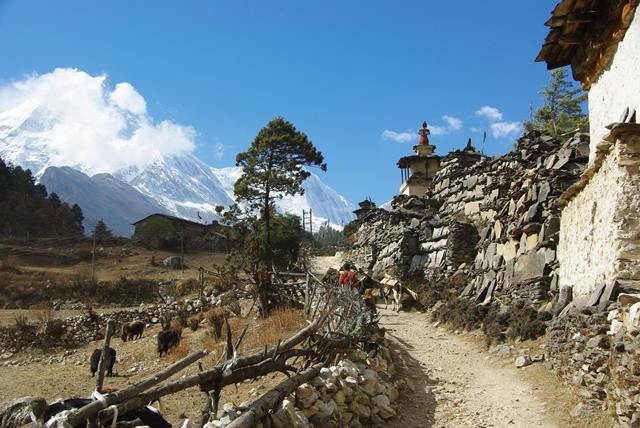
The Manaslu region in Nepal has a rich spiritual significance, as it is home to several ancient Buddhist monasteries and sacred sites. Here are some of the spiritual highlights of the Manaslu region:
Manaslu Mountain: The Manaslu mountain, which is the eighth highest mountain in the world, is considered a sacred peak by the local people. It is believed that the mountain is the abode of the powerful Buddhist deity known as Manaslu.
Buddhist Monasteries: The Manaslu region is home to several ancient Buddhist monasteries, including the Rachen Gompa and Mu Gompa in Tsum Valley, and the Sama Gompa in Sama Gaon. These monasteries are important pilgrimage sites for Buddhists and are renowned for their intricate carvings, beautiful paintings, and ancient artifacts.
Lho Monastery: The Lho Monastery, located in the village of Lho, is one of the oldest and most important monasteries in the region. It is believed that the monastery was founded by a renowned Buddhist master named Lama Ngawang Tsultrim in the 19th century.
Prayer Flags: Prayer flags are a common sight in the Manaslu region, and they are used to promote peace, compassion, and good fortune. The flags are inscribed with sacred mantras and symbols, and they are believed to spread blessings and positive energy to the surrounding environment.
Chortens: Chortens, which are also known as stupas, is another important feature of the Manaslu region. These ancient structures are used as places of meditation and worship, and they are often decorated with colorful prayer flags and offerings.
Climate change is having a significant impact on the Manaslu region and the Manaslu trek. Here are some of the ways in which climate change is affecting the area:
Glacier melting: The Manaslu region is home to several glaciers, including the Manaslu Glacier. Due to rising temperatures, these glaciers are melting at an alarming rate, which is affecting the local ecosystem and water supply.
Changing weather patterns: Climate change is causing changes in weather patterns in the Manaslu region, with more frequent and intense rainfall events and snowfall. This can make trekking in the area more challenging and increase the risk of landslides and avalanches.
Increased risk of natural disasters: As a result of melting glaciers and changing weather patterns, there is an increased risk of natural disasters such as floods, landslides, and avalanches in the Manaslu region.
Impacts on flora and fauna: Climate change is affecting the local flora and fauna in the Manaslu region, with some plant and animal species becoming endangered or even extinct due to changes in temperature and precipitation patterns.
Impacts on local communities: Climate change is also affecting the local communities in the Manaslu region, with changes in rainfall patterns affecting agriculture and water supply. This can have a significant impact on the livelihoods of local people.
To mitigate the impacts of climate change on the Manaslu region, it is important to take action to reduce greenhouse gas emissions and promote sustainable development in the area. This includes supporting local communities in adapting to the impacts of climate change and promoting responsible tourism practices that minimize the environmental impact of trekking in the region.
The weather and temperature during the Manaslu Circuit Trek can vary depending on the season and altitude. Generally, the best time to do the trek is during the Autumn (September-November) and spring (March-May) seasons when the weather is stable and clear, and the temperature is mild.
During these seasons, trekkers can expect pleasant daytime temperatures ranging from 15-20°C (59-68°F) at lower altitudes and dropping to around 0°C (32°F) at higher altitudes. However, temperatures can vary widely between day and night, so it’s important to bring warm clothing, including a good quality down jacket and thermal layers.
In the winter months (December-February), the Manaslu Circuit Trek can be challenging due to the cold temperatures and occasional snowfall. Daytime temperatures can drop to below freezing, and night temperatures can plummet to around -15°C (5°F) or lower. Therefore, trekkers should be well-prepared with warm clothing and gear.
In the summer months (June-August), the Manaslu Circuit Trek can be wet and muddy due to the monsoon season. The trail can be slippery, and there is a risk of landslides and floods. Trekkers should be prepared with waterproof clothing and gear and be cautious of the trail conditions.
Overall, the weather and temperature during the Manaslu Circuit Trek can vary widely, so it’s essential to check the weather forecast and plan accordingly. Trekkers should bring appropriate clothing and gear for the season and altitude and be prepared for any unexpected changes in weather.
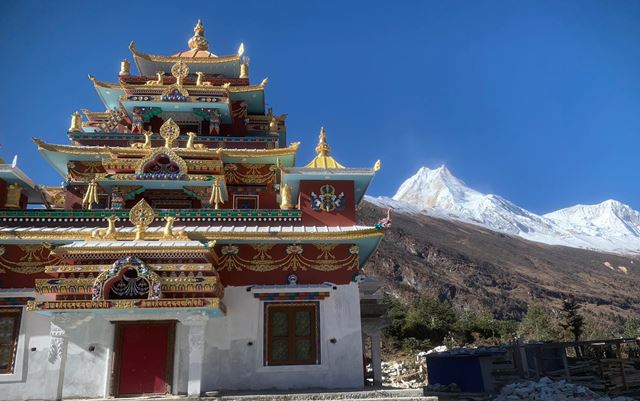
Manaslu mountain view and Beautiful Buddhist Gompa
The Manaslu Trek is a popular trekking route in Nepal that offers breathtaking views of the Himalayas and the Manaslu peak. There are several routes to choose from when trekking in the Manaslu region, each offering a unique experience. Here is a comparison of the different routes on the Manaslu Trek:
Manaslu Circuit Trek: The Manaslu Circuit Trek is the most popular and well-known trekking route in the Manaslu region. The trek starts in the town of Arughat and goes through the Budhi Gandaki valley, passing through remote villages, lush forests, and crossing high mountain passes. The trek takes about 14-16 days to complete and offers stunning views of the Manaslu peak.
Tsum Valley Trek: The Tsum Valley Trek is a relatively new trekking route that takes you through the hidden Tsum Valley, a remote valley located in the northern part of the Gorkha district. The trek offers a unique cultural experience as you get to visit ancient monasteries, interact with the locals, and learn about their way of life. The trek takes about 18-20 days to complete and is less crowded than the Manaslu Circuit Trek.
Manaslu Rupina La Trek: The Manaslu Rupina La Trek is a challenging trek that takes you through the Rupina La pass, one of the highest passes in the Manaslu region. The trek offers stunning views of the Himalayas and takes you through remote villages, beautiful forests, and high-altitude terrain. The trek takes about 18-20 days to complete and is recommended for experienced trekkers.
Ganesh Himal Trek: The Ganesh Himal Trek is a lesser-known trekking route that takes you through the beautiful Ganesh Himal range. The trek offers stunning views of the Himalayas, including the Ganesh Himal peak, and takes you through remote villages, lush forests, and high mountain passes. The trek takes about 14-16 days to complete and is a good alternative to the more crowded Manaslu Circuit Trek.
In conclusion, the Manaslu region offers a variety of trekking routes that cater to different interests and skill levels. The Manaslu Circuit Trek is the most popular and well-known trekking route, while the Tsum Valley Trek offers a unique cultural experience. The Manaslu Rupina La Trek is a challenging trek for experienced trekkers, while the Ganesh Himal Trek is a good alternative to the more crowded Manaslu Circuit Trek.
The Manaslu Trek is a beautiful and challenging trek that takes you through remote and rugged terrain in the Himalayas. To ensure a safe and enjoyable experience, here are some tips to keep in mind:
Acclimatize properly: Acclimatization is crucial when trekking in high-altitude regions. Take your time and don’t rush through the trek. Walk at a slow and steady pace, and take regular breaks to rest and hydrate.
Hire a licensed guide: It is highly recommended to hire a licensed guide who is familiar with the terrain and has experience in guiding trekkers. They can help you navigate the trail, provide insights on local culture, and ensure your safety.
Stay hydrated: It’s easy to get dehydrated at high altitudes, so drink plenty of water throughout the trek. Avoid drinking untreated water and carry a water filtration system or purification tablets.
Dress appropriately: The weather in the Himalayas can be unpredictable, so it’s important to dress in layers and bring warm clothes. Wear sturdy hiking boots and socks to protect your feet.
Carry a first-aid kit: It’s always a good idea to carry a first-aid kit with basic medicines, bandages, and ointments in case of any injuries or ailments
Respect local customs: The Manaslu Trek takes you through remote villages where local customs and traditions are still prevalent. Be respectful of their beliefs and practices, and ask for permission before taking photographs.
Be aware of altitude sickness: Altitude sickness can affect anyone, regardless of fitness level. Symptoms include headache, dizziness, and nausea. If you experience any of these symptoms, descend to a lower altitude immediately and seek medical attention if necessary.
Carry sufficient supplies: The Manaslu Trek is a remote trek, so it’s important to carry enough supplies such as food, water, and warm clothes. Stock up on these supplies at teahouses along the trail.
By following these tips, you can enjoy a safe and memorable trek on the Manaslu Circuit.
In conclusion, the Manaslu Trek offers a challenging and rewarding adventure for trekkers seeking a unique and authentic experience in Nepal. The trek offers stunning views of the Himalayan mountain range, passes through diverse landscapes, and provides a glimpse into the local culture of the region. With proper preparation and guidance, the Manaslu Trek can be completed by trekkers of different experience levels. For those planning to embark on this adventure in 2023 and 2024, it is important to obtain the required permits, pack appropriately, and choose a reliable trekking agency to ensure a safe and enjoyable trekking experience. Overall, the Manaslu Trek is a must-visit destination for adventure seekers looking for an unforgettable trekking experience in the heart of the Himalayas.